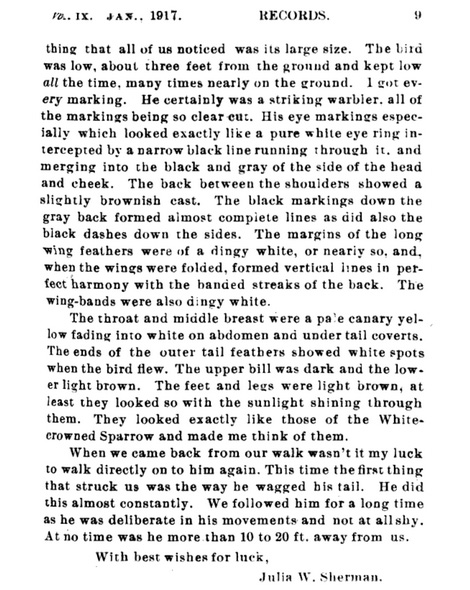
Julia Sherman’s letter to Charles Maynard

Page 2 of Mrs. Sherman’s letter.
1 records
| MARC number | Decision | Species | # | Location | County | Arrival | Departure | Observers | Report |
|---|---|---|---|---|---|---|---|---|---|
| 1916-002 | A | Kirtland's Warbler | 1 | Roslindale | Suffolk | 5/26/1916 | 5/26/1916 | J. Sherman*, C. Sherman*, Mrs. Hodgskins* | 15 |
The state’s only Kirtland’s Warbler record was discovered by Julia Sherman, her daughter Catherine, and Mrs. Hodgskins—all three top students of Charles Maynard’s Saturday Bird Class—on May 26, 1916, in Roslindale.
The first thing Mrs. Sherman mentioned was the large size, and Kirtland’s are indeed giants of the Parulidae. She then described key plumage details, which she was able to observe by getting within three feet of the bird. Most significantly, she described a “clean cut” bird with a white eye ring “bisected by a black line,” black and gray on the side of the head and cheek (indicating a male), a slight brownish cast to the back (suggesting a first spring male, the most likely candidate for vagrancy), black lines on the back and flanks, pale canary yellow belly fading to white undertail coverts, white spots on the ends of the outer tail feathers, and “dingy white” edged wing feathers, forming more linear stripes (a particularly subtle detail that lends credibility to the whole report).
Finally, Mrs. Sherman described the behavior, which was a critical selling point for many members. The bird was seen feeding low and often on the ground. While any warbler can feed on the ground, few do it consistently over prolonged observation. Even better, she was struck by the bird’s persistent tail wagging. Three warblers (or four, but western Nashville [Oreothlypis ruficapilla ridgwayi] has more of a tail flick) persistently wag their tails: Palm (Dendroica palmarum), Prairie (Dendroica discolor), and Kirtland’s. Nothing in the description suggests the bird was a Palm or Prairie.
To read more about the birds Mrs. Sherman recorded around her Roslindale home, see Record of Walks and Talks With Nature by Charles Maynard.
